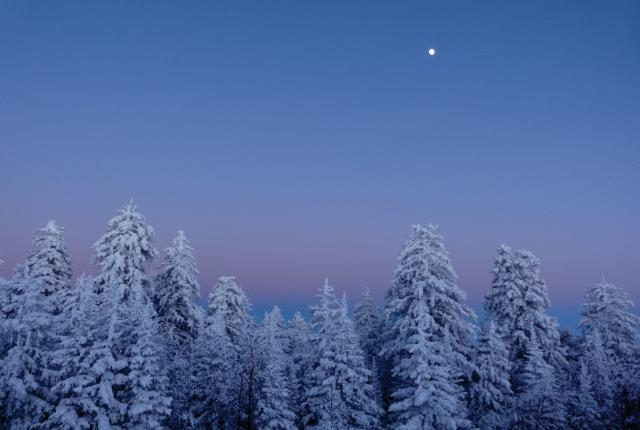Above: Winter on the Sandia Mountains.
Sandía: Seasons of a Mountain
Photographs by David Muench, essay by Ruth Rudner (University of New Mexico Press)
Sandía Mountain wasn't the first rugged place in New Mexico to enchant me. That honor goes to the Gila National Forest. It wasn’t even the second—that would be the Sangre de Cristos. But during three decades of living amid Sandía’s northern foothills, in Placitas, I’ve spent more time, logged more miles, and crafted more memories on its slopes than on any other. It’s endangered my life a time or two. It’s saved my soul many times over.
A mountain on the eastern edge of the state’s biggest city is bound to get a lot of love from a lot of people, most recently in Sandía: Seasons of a Mountain. This lusciously produced volume consists of images by celebrated landscape photographer David Muench, plus a wise and lyrical essay by Ruth Rudner, a nature writer whose previous books include A Chorus of Buffalo. The couple, who now live in Montana, spent years watching Sandía’s western face from their Corrales home and exploring its trails with such frequency that I have to wonder if we ever crossed paths.
As mountains go, Sandía presents conundrums. It’s one of the few national wilderness areas to bump against an urban environment. It’s open to hikers, climbers, skiers, and hang gliders, but the portion from Tramway Boulevard up to the crest is actually owned by Sandía Pueblo. The claim to what the tribe calls T’uf Shur Bien (Green Reed Mountain) didn’t win federal recognition until 2001, and by then anyone with a backpack felt they had a right to it. A tribal compromise keeps the land open, although, as Rudner notes, it ought to guide our conscience in how we use it.
As illustration, she recalls the words of former Sandia Pueblo Governor Stuart Paisano, when the T’uf Shur Bien Preservation Trust was signed into law: “Our elders, who know the mountain better than anyone, tell us that it is hurting—springs have dried up and plants and wildlife have disappeared or retreated. … Let us all be mindful of our responsibility to be good stewards of the mountain and to be vigilant in our efforts to protect it.”
Muench’s images serve as a poetic portrayal of what we risk losing should that stewardship falter. Shifting easily from telescopic to microscopic views, he reveals heavenly sunsets, delicate snow patterns, distant snow cranes, and the fractal effects of bare branches on clouds. With more than 60 books under his lens, Muench has admirers and collectors around the world. His photo subjects range from Antarctica to Mongolia. Bringing his prowess to the mountain he knows best represents a gift to everyone in the state—especially given the fragility of Sandía’s beauty.
Years of depleted snowpacks and paltry rains have rendered it enough of a fire hazard that the U.S. Forest Service regularly closes it for entire summer months. And yet, anytime it’s open, a happy wanderer can easily leave the most popular trails to discover solitude, hidden waterfalls, rare wildflowers, and the wildlife equivalent of a zoo. The mountain’s cacophony of geology, botany, and biology are alternately blessed and battered by people, climate, and federal budgets. For all of its perils, it holds continual surprises, including the promise of a new awakening just steps away from the eight-to-five city grind.
In my years of driving home from jobs in Santa Fe, I’ve had time to study Sandía’s silhouette, blue-gray against neon skies. I always see a woman in labor. She lies on her back, hair streaming down toward the Río Grande. Moving my eyes east, I can pick out her forehead, nose, lips, and breasts, see her knees raised. “But what is she giving birth to?” a puzzled friend once asked when I attempted to point it all out. “To the mountain,” I whispered, my eyes fixed on her form. “She is always giving birth to this mountain.”


